Trains of Yesteryears by
Rick Spacek
There are five different train scenes cut out of thin
slabs of pecan, black backer with plywood.
The frame is made of oak
It is 2’ w x 5’ l x 1”t
Painted with acrylic paints. Photos are
before and after.
Earl Touchstonecreated this beautiful side-table in response to the Furniture Splinter’s build a table challenge
Gary Rowen made a planter from mostly left over western red cedar and finished with Behr's Semi-Transparent Weather Proofing Redwood Stain.

 These are abstract bowls. I call them “what the
hael are they”? Made from maple and mahogany with bandsaw, scrollsaw,
and drill, and finished in wax.
By Lon Kelley
These are abstract bowls. I call them “what the
hael are they”? Made from maple and mahogany with bandsaw, scrollsaw,
and drill, and finished in wax.
By Lon Kelley

Cutting Board - 12" x 18" x 1 1/4" Walnut and Maple. Design came to me
in a moment of panic after I had routed some grooves for a wooden hinge
on a small jewelry box that was cut too shallow but did not realize
until the glue was dried, and I was looking at my gauge pieces I use to
set the router bit depth and fence with a 1/4" dowel in the gauge
pieces. I am preparing some instructions so I can make another, and
once they are complete I will send them to be posted on the club
website. The dowels are 3/4" and the squares are 1 1/2" x 1 1/2", or as
close as I could get. If you look closely, you will see that the corners
where the blocks meet are not dead on, but short of $5 Grand worth of
precision equipment and 15 years of practice, I say "Close enough". A
bit of one of the maple dowels had some nice figure, as seen in the
close up. Probably 25 hours in it, 20 hours figuring out how to do it
and set up, 1 hour looking for things, and maybe 4 hours of actual work
- mostly final sanding that darn end grain to 400.



Denis Muras started with a run of over 25 copies, but always more. They are made from scrapwood, similar to Winkwood, but found lying around my humble shop, walnut, maple, mahogany, cherry and others I found.
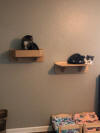



Chris Farquhar made these for a co-worker of his wife. She has a number
of the cats and wanted something they could climb across on the walls.
The original site where she saw these designs, stop making / selling
them, so I put my own spin on the design; and the cats like them. Made
out of 3/4" Birth Plywood using dados and glued together. The only
fasteners used are what holds them to the wall. There is (1) Corner
Shelf; (2) Bed Shelves; (3) Flat Shelves.
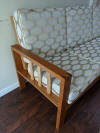

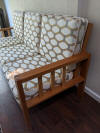

This is part of a 3 + 1 + 1 Amish style Wooden sofa set. the two single
seaters are being built now!! This is for indoor use and made of Cherry.
The slats and accent dowels are Maple. Dimensioned all parts using
Planer and Table saw. All joints are cut by Hand. The seat frame sits on
the grooves notched into the side leg frames. The Maple slats in the lag
frame are Mortise and Tenoned in. The Maple slats on the back rest are
glued and nailed into a rabbet. By Sankar Padhmanabhan
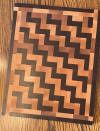
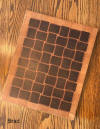

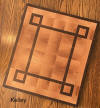
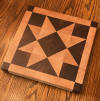
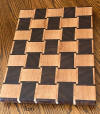
I've been busy making end grain cutting boards for my family. By Jack
Bailie



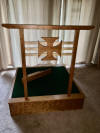
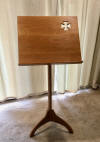
My most recent conductors' podium and conductors' music stand commission for Strake Jesuit High School here in Houston. Both are cherry with some maple. The substructure of the podium is ash, and the carpet is an outdoor carpet (hard to find green...). The cross is the Crusader's Cross from their school crest. The podium is 40" x 40" x 9" and the top of the railing is 36" above the surface. The railing comes out, and there is an insert for when it is not being used. The desk on the stand is 24" x 20", and the base is a little heavier since that is bigger than what I usually do. Both are finished with Waterlox. By Mike Hardy
Bowls, from left to right:
First, unknown wood from a retired woodworker, ("FOF" wood), but definitely curly spalted something! 12" x 2 1/4"
Second is a walnut bowl with wild grain, including a burl on one side,
13" x 2 1/2".
Third, a shallow bowl/platter of Water Oak, just under 15" diameter and
2" high. Great red color; the dark grey streak across the middle
is from nails buried in the wood further up the tree.
All three are lathe turned, and "finished" with tung oil. One nice
thing about my wood drying room is that I can also use it to dry and
harden and recoat with tung oil in just a few hours, instead of 24
hours.
Last December, Bill Lindsey, Jeff Larsen, and I first split a big water
oak log, then milled it into boards. I have been drying it since,
and in May decided it was ready. So far I have completed a big
table and a bench. The table is 42" x 96" and the top is 1 1/2"
thick. with 3" x 3" legs, and the apron parts at 1 1/2" x 3 1/2",
it weighs about 225 pounds. Very simple construction, it uses two
3/8" hanger bolts and kerf mounted corner brackets to attach the legs
and apron, and table top fasteners to attach the top, and allow for wood
movement. Those are all from Rockler, where they have surprisingly
good prices. The live edges, with bark removed, were very lightly
sanded, then stained with Minwax gunstock stain, kind of orange color.
Then I finished with minwax helmsman water based clear gloss spar
urethane. Five coats for the table top, and three for everything
else. For the gloss finish and wood to show off each other, I had
sanded to 400 grit.
The matching bench is 16"-17 1/2" wide by 76" long, seating 3-4 people.
I initially had legs only at each end, but decided that was not strong
enough, especially for today's sized Americans, and added middle legs.
Now it should certainly support 1,000 pounds without sagging. To
save some construction time, I used Kreg pocket screws for the apron and
legs, (my first time trying these,) and the same table top fasteners to
attach the seat.
Very pretty wood, with lots of rays, and nice red color, but hard to
work. Lots of splintering, brittle wood. I ended up often
using a router climb cut to round over the edges and avoid losing long
chunks. Also dried with some moderate checking, which I filled in
where needed with matching sawdust and Titebond I glue homemade wood
putty. (The lighter color glue matches the color better than
Titebond III. Yes, I'm learning!)
By David Janowitz